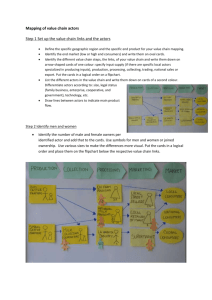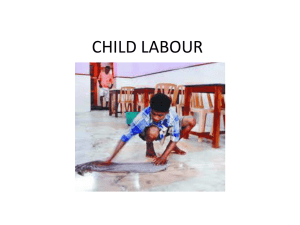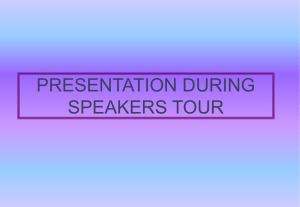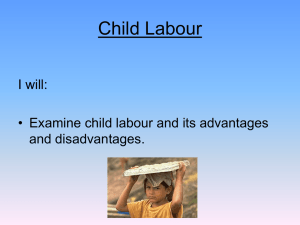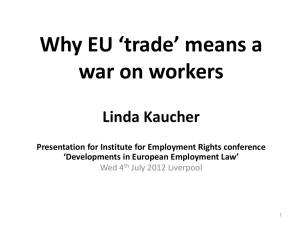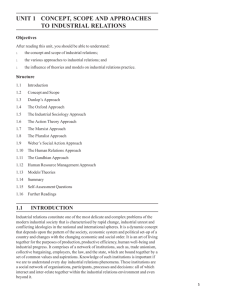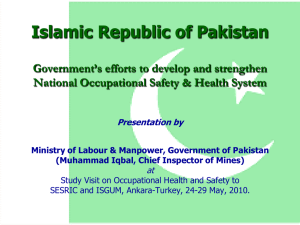industrial relations-concept
advertisement
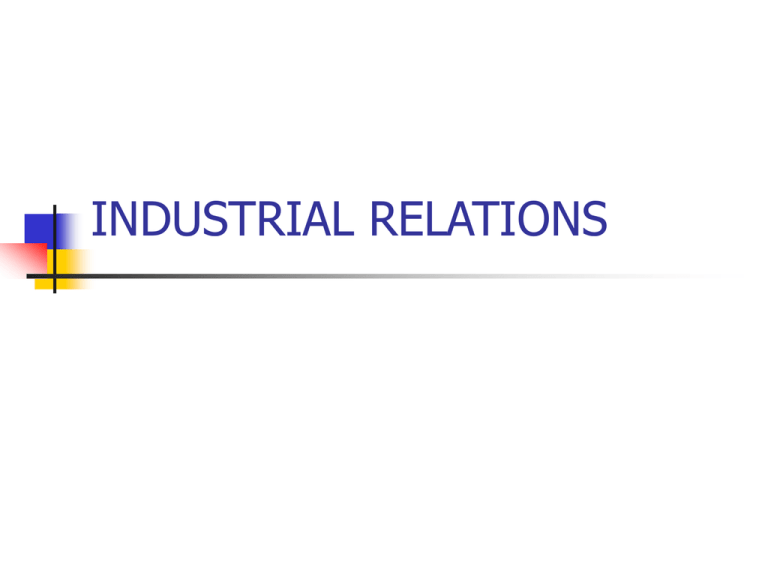
INDUSTRIAL RELATIONS Trends in Industrialization-at early stage Loss of freedom Unhygienic working conditions Employment of children Freedom to contract Dynamics of market INDUSTRIAL RELATIONS-CONCEPT Deals with people who are the base of industry Behind every activity there is a human being Problem of IR is most prominent Process by which people and their organ interact at the place of work to establish terms & conditions of employment Denotes employee-employer relations or Labour-management relations NOTABLE FEATURES OF IR Involves both conflict & co-operation Environmental issues impact stronglytechnology, socio-economic, political and labor policy, trade union’s attitude Relates to study of Laws, rules, awards of courts SCOPE OF IR Labour relations I.e.relations between union & management Employer-employee relations-relations between mgmt & employees Group relations-relation between various groups of workmen COMPONENTS OF IR SYSTEM It comprises of 3 actors: Workers (Employees) and their organizations (Trade unions) Management (Employers) and their organizations (Employers assoc/ federation) Government APPROACHES TO IR Psychological approach: Mgmt. and labour see each other as non dependable and looked upon with suspicion Sociological approach: Value systems,customs,norms,attitude & perception of both labour and mgmt affect IR Scanning of all social factors call of time APPROACHES TO IR (contd..) Human relations approach: Most delicate & tricky HRM policies relating to motivation and leadership style play key role Study of human needs very importantQWL APPROACHES TO IR (contd..) Socio-Ethical approach: IR has some ethical implication Creation of willingness to co-operate as partners Development of a code of ethics & a mgmt philosophy Mgmt. and workers should feel the urge for joint consultation VVGiri -”Stress on collective bargaining & mutual negotiations for settlement of disputes APPROACHES TO IR (contd..) Gandhian approach: Peaceful co-existence of capital & labour Resolution of conflict by non-violent,non cooperation Accepted worker’s right to strike but in a just case Capitalist expected to hold industry in trust for community.No room for conflict India’s IR system largely influenced by this approach APPROACHES TO IR (contd..) System approach: John Dunlop developed a system approach It is an ideological linkage • Market Restraints • Technology • Distribution of Power in Society Union – Mgmt Govt. Output is result of interaction Rules of Workplace INDUSTRY EMPLOYER LABOUR [MANGEMENT] [TRADE UNION] INDUSTRIAL RELATION IS INTERACTION BETWEEN THE TWO STAKE-HOLDERS AT WORK PLACE TO HARMONISE CONFLICTING INTERESTS MANAGEMENT INTEREST HIGH LEVEL OF PRODUCTIVITY MAXIMUM PROUCTION OPTIMUM UTILISATION OF RESOURCES DICIPLINED WORK FORCE INDUSTRIAL PEACE TO MAXIMISE PROFIT LABOUR INTEREST HIGH REMUNERATION FULFILMENT OF HUMAN NEEDS AND WANTS RECOGNITION, OTHER SOCIAL NEEDS PARTICIPATION IN DECISION MAKING PROTECTION OF RIGHTS, RIGHT TO ORGANISE AND UNIONISE CAREER GROWTH JOB SATISFACTION HOW TO HARMONISE CONFLICTING INTERESTS MANAGEMENT TRANSPARENCY INFORMATION SHARING BE FAIR AND REASONABLE GRIEVANCE REDRESSAL MECHANISM SOCIAL DIALOGUE COMPLIANCE WITH LABOUR LAWS HUMAN RESOURCE DEVELOPMENT RECOGNITION TRADE UNION RECOGNISE RIGHTS AND OBLIGATIONS OF MANAGEMENT KNOW CAPACITY OF INDUSTRY TO PAY REASONABLE EXPECTATIONS AND DEMANDS EDUCATION OF WORKERS SETTLEMENT OF DEMANDS ONLY THROUGH LEGITIMATE, DEMOCRATIC METHODS PRE-REQUISITES FOR SUCCESSFUL IR PROGRAMME Top management support Development of sound HRM & IR policies Implementation of effective HR & People friendly practices Provision of adequate training CHARACTERISTICS OF IR SYSTEMS IN INDIA TODAY Unions restricted to organized sector & multiplicity Varying management styles Excessive state intervention Lacunae in Labour legislation Disputes largely relating to wages Collective bargaining gaining popularity No stated National Policy on IR More accommodating mood setting amongst workforce in wake of New Economic Policy ROLE/BEHAVIOUR OF ACTORS (1) WORKERS: Form unions to safeguard interests and act as bargainers In India there are 10 central organizations Mainly political institutions and a regulatory device to management actions ROLE/BEHAVIOUR OF ACTORS (2) MANAGEMENT Key actor in the system Manner to get work done determines the quality of relations Likert identified following leadership styles: Exploitative & authoritative system Benevolent authoritative system Consultative Management Participative Style ROLE/BEHAVIOUR OF ACTORS (3) GOVERNMENT Govt acts as a regulator & judge th century ,govt. never bothered to Till 19 intervene Only early 40’s govt. laid need for consultation with labour & management. Enacted legislations, acts & labour laws. “ In globalization set up,increasing awareness of workers,complexities,the relations of 3 actors will become more complex’



